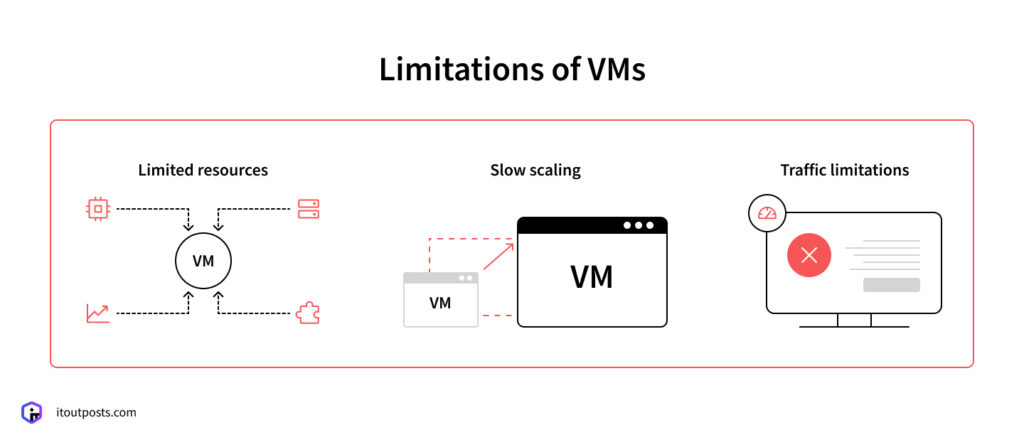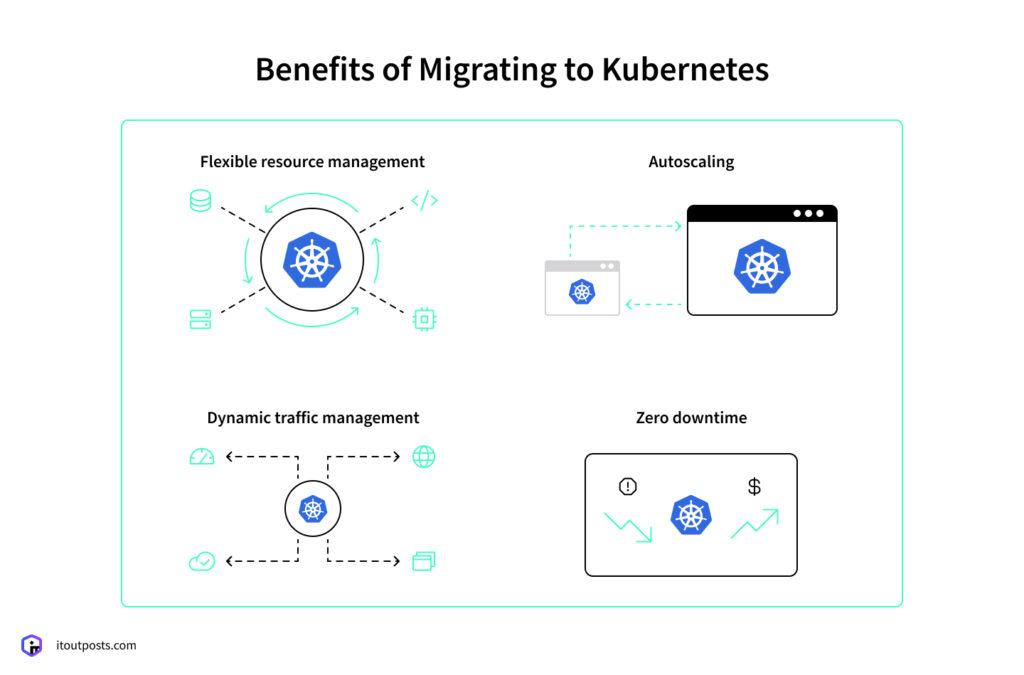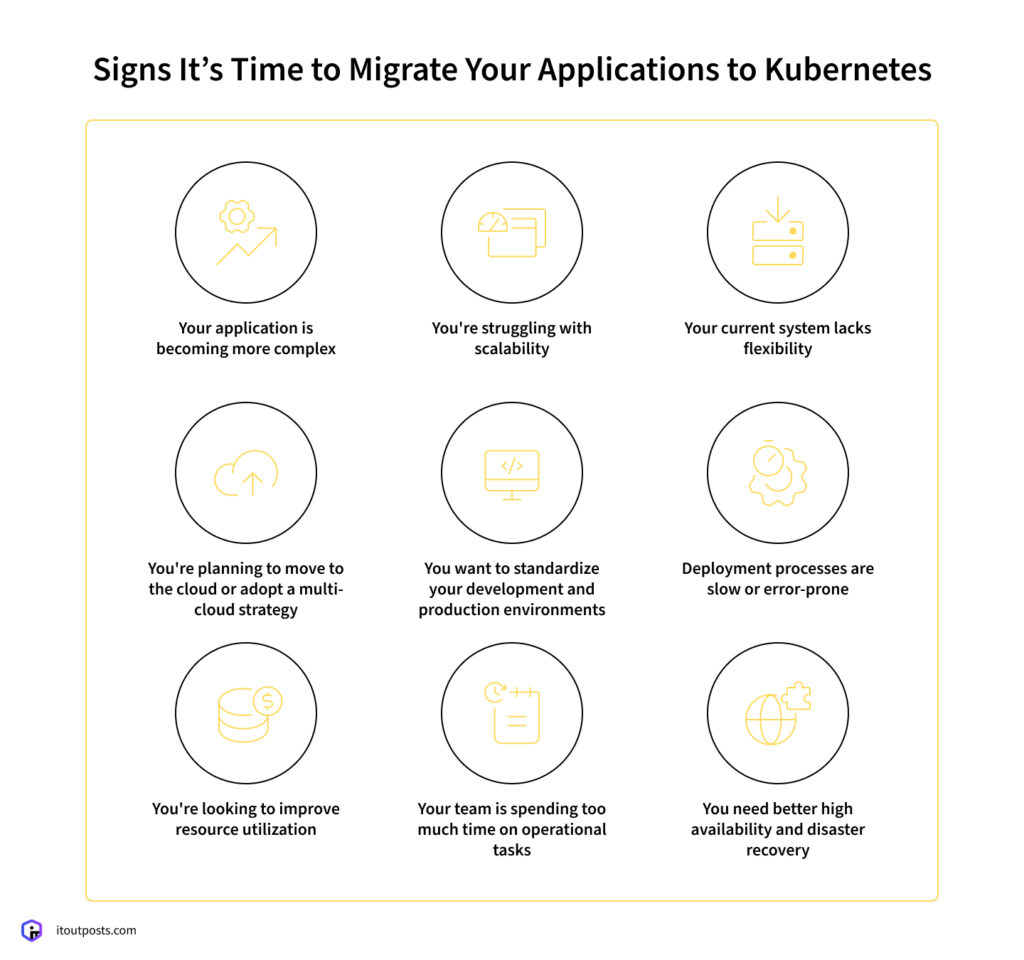Contents
Some businesses still rely on traditional virtual machine (VM) environments for their application deployments. Chances are, you’re too familiar with the complexities that come with this approach — scalability issues, reliability concerns, and inefficient resource utilization, to name a few. It’s a struggle that can hold your business back.
Why continue struggling with manual deployments and large downtimes when there’s Kubernetes, a robust container orchestration platform that can streamline your operations? With its help, you can scale your applications up or down with just a few clicks and even automatically with the right setup, so your resources are always aligned with your business needs. While Kubernetes migration might seem like a big undertaking at first, the efforts will pay off in the long run. In this article, we’ll explore the limitations of VMs and discuss how Kubernetes elegantly solves these issues.
Virtual Machines: How It All Started
Before VMs, businesses would dedicate an entire physical server or machine to running a single application or performing a specific task. This approach often leads to underutilization of hardware resources, as most applications don’t require a server’s full capacity.
Virtual machines changed this paradigm by allowing businesses to create multiple isolated virtual environments on a single physical machine. Each VM can run its own operating system, applications, and configurations, letting organizations consolidate their workloads onto fewer physical servers.
Indeed, virtual machines were a game-changer when they first emerged. Yet, with more powerful systems like Kubernetes gaining traction, the advantages VMs once had are fading away.

Limitations of VMs
As we continue to move further into the digital age, adopting a microservice architecture, the limitations of VM environments become increasingly apparent. Here are the main ones.
Limited resources
Virtual machines have a fixed allocation of CPU, RAM, disk space, etc. You can’t simply add more resources on demand. If your application needs more power, you have to recreate the VM with higher specs. This also means you may need to overprovision resources to handle traffic spikes. But then you’re paying for underutilized capacity. Limited resources directly impact performance under high load. Your app will slow down or even crash if it maxes out the VM’s capabilities.
Slow scaling
Need more capacity? With VMs, scaling is a manual process that takes time. You have to provision a new, larger VM and migrate or replicate your app. This is too slow if you need to instantly handle demand spikes. By the time you’ve scaled, the business opportunity is missed. Scaling down is similarly cumbersome — you have to resize or consolidate VMs.
Traffic limitations
Even minor traffic spikes can overwhelm virtual machines if they don’t have enough resources. Their fixed capacity can easily be maxed out under bursts of high load, causing errors, slowdowns, crashes, etc. Plus, there’s no automatic load balancing or failover. The only solution is overprovisioning — assigning way more resources than needed most of the time, which is definitely not cost-effective.
Downtime risks
Most changes to VMs require restarts, redeployments, or even recreating them. This inherently risks downtime and service disruptions. Migrating data, updating configurations, etc., can potentially cause data loss or unavailability. These risky manual processes are also error-prone. One missed step, and you face an outage. High-uptime services especially struggle with VM maintenance.
So, running your infrastructure on VMs definitely seems old-fashioned, especially when we look at the capabilities of Kubernetes, an advanced platform for container orchestration. Now, let’s compare how it can compensate for all the disadvantages of VMs.

Benefits of Migrating to Kubernetes
If we look back at the history of container orchestration, everything began with containerd. Later, Docker came along, offering a more user-friendly interface to containerd. Despite its enduring popularity and widespread use, Docker still presents a learning curve for many.
Then, developers realized the limitations of housing entire applications in a single container. This realization led to the introduction of Docker Compose, which made it easier to create compositions from multiple containers. While this was a significant improvement and simplified workflows, it wasn’t enough for larger scaling requirements, especially for AI-powered service management, which needs massive data processing capabilities.
This scalability challenge raised the question: “How can we further optimize this process?” The answer came in the form of Kubernetes, which can automate many of the processes and increase flexibility in scaling workflows. Kubernetes represents a paradigm shift in container orchestration and solves the complex problems its predecessors can’t fully solve. Let’s take a look at the main strengths of migrating applications to Kubernetes in comparison to old-school virtual machines.
Flexible resource management
While VMs have fixed allocations of CPU, RAM, and disk space, Kubernetes offers a much more flexible approach to resource management. After project migration to Kubernetes, you aren’t bound by predetermined resource limits. It allows for dynamic allocation of resources based on the needs of your application. If your app needs more performance, you don’t have to recreate an entire VM with higher specifications. Kubernetes can automatically adjust resource allocation on the fly.
Autoscaling
This flexibility also extends to scaling. Instead of over-provisioning a VM to handle potential load spikes, Kubernetes can automatically scale your applications. When the load decreases, scaling can be reversed so you don’t have to pay for unused capacity.
Dynamic traffic management
Kubernetes offers a much more robust approach to handling variable workloads. Migration of VM-based deployment to Kubernetes will allow you to dynamically adapt to changing demands.
When traffic surges, Kubernetes can scale horizontally or vertically. With horizontal autoscaling, the number of running instances (pods) is automatically increased or decreased to cope with changes in the workload. Vertical autoscaling adjusts the CPU and memory resources allocated to existing pods so that they can handle more work without increasing the number of instances.
Kubernetes can also distribute incoming network traffic across multiple instances of your application. It’s done without the need for manual intervention.
Zero downtime
Kubernetes significantly mitigates the failure risks associated with virtual machines. It employs rolling updates, so you can gradually replace old versions of your application with new ones. This approach ensures your service remains available during the update process. When configuration changes are made, Kubernetes can also apply them without the need to restart the container, further reducing potential downtime.
What’s more, the platform’s self-healing capabilities contribute to improved uptime. If a container fails, Kubernetes automatically replaces it, often before users even notice a problem.
Clearly, the benefits of Kubernetes go beyond technical management efficiency and offer significant potential to improve your organization’s bottom line. The following section provides insights to help you decide whether moving to Kubernetes aligns with your current business needs and strategic goals.

Signs It’s Time to Migrate Your Applications to Kubernetes
As your company grows, its infrastructure requirements often change. Kubernetes has proven to be a powerful solution, but how do you know if it’s the right time for your organization to make the switch? Let’s take a look at some key indicators that suggest it’s time to consider an app migration to Kubernetes.Your application is becoming more complex
As your application grows, you may need to manage an increasing number of microservices. When coordinating these different parts becomes a challenge, Kubernetes can help. It’s designed for complex, distributed systems and can simplify the management of interconnected services.You’re struggling with scalability
If your current infrastructure is struggling to cope with traffic spikes or you’re constantly having to manually provision new resources, moving an application from VM to Kubernetes could be the solution. Its built-in autoscaling features can automatically adjust your resources to meet demand and ensure your app remains responsive without wasting resources during quieter times.Your current system lacks flexibility
When business needs change, your infrastructure must be able to adapt quickly. If your current setup makes it difficult to add new features or services, Kubernetes’ modular approach can provide the flexibility you require.You’re planning to move to the cloud or adopt a multi-cloud strategy
Kubernetes is cloud-agnostic, so it’s an excellent choice if you’re planning a move to the cloud or want the flexibility to use multiple cloud providers.You want to standardize your development and production environments
Infrastructure migration to Kubernetes can help create a more consistent environment across development, testing, and production, reducing these issues.Deployment processes are slow or error-prone
Frequent deployments are part of modern development practices, but if your current system makes this process slow or risky, it’s time for a change. Kubernetes provides continuous deployment tools and rolling updates that make it easier to publish changes quickly and securely.You’re looking to improve resource utilization
Virtual machines often lead to underutilized resources. If you’re paying for more computing power than you’re actually using, Kubernetes can improve resource utilization, potentially reducing your infrastructure costs.Your team is spending too much time on operational tasks
If your developers or operations team spends more time managing infrastructure than improving your product, Kubernetes can help shift this balance. Kubernetes can reduce the manual labor involved in maintaining your application environment.You need better high availability and disaster recovery
If downtime is a major issue for your organization, Kubernetes offers features that can improve the availability of your application. Its ability to automatically redistribute workloads during node failures and its support for multi-region deployments can improve your disaster recovery capabilities. Moving to Kubernetes is more than just a technical upgrade — it’s a smart business move that can change the way your entire organization works with technology. Ultimately, the decision to adopt Kubernetes should align with your larger plans for your organization. If done well, it can help your company become more innovative and ready for future change. While it’s important to understand the potential benefits of Kubernetes, nothing illustrates the impact better than real-world examples.Success Stories of Migrating from VMs to Kubernetes
IT Outposts has supported numerous customers with VM-to-Kubernetes migration. Let’s take a look at some of these case studies that show how we’ve helped companies from different industries successfully implement Kubernetes and the tangible results they’ve achieved.
Vidby: AI-powered translation startup
Vidby is a cutting-edge AI-powered translation company that is transforming cross-cultural communication. Their application provides AI real-time translation, caption generation, and voice-over services for video content.
The challenge was that their existing infrastructure, based on basic virtual machines in the Hetzner cloud, was holding them back. This setup required manual code releases, which slowed down their ability to continuously refine their AI models and caused delays that could potentially damage the company’s credibility.
Migration to Kubernetes with our AIOps kubernetes expert help dramatically boosted Vidby’s agility and enabled automated CI/CD pipelines and updates without downtime. The new infrastructure enhanced scalability, allowing Vidby to easily meet growing demand. The result was a significant improvement in developer productivity, faster feature releases, and higher customer satisfaction.
Construction Software Giant
This case study is about a construction software company that serves large construction projects. Their software helps construction firms plan every detail before they start building — 3D designs, costs, schedules, and labor requirements.
Our clients wanted to make their software more reliable as they grew. They were using a complicated system with many virtual machines that were difficult to manage. That’s why they brought in IT Outposts to develop a comprehensive Kubernetes migration strategy and streamline the reliability of their software.
We moved the company’s platform from virtual machines to Kubernetes. This switch made the system more flexible, so our clients can better manage growth. It’s now easier to maintain operations without disruption and roll out updates and new features much faster and more cost-effectively.
Conclusion
While VMs have been reliable solutions for a long time, they can’t keep up with the demands of modern, rapidly changing applications anymore. So, why migrate to Kubernetes? Companies that use this advanced orchestration platform often see much more clear benefits: lower operating costs, faster release of new features, and more productive development teams. The platform lets you maintain consistent environments for development, testing, and production, reducing compatibility issues. Kubernetes also enables advanced DevOps practices and promotes a culture of continuous improvement and delivery.
Organizations looking to make this switch should be aware that the process requires careful planning and expertise. IT Outposts will guide you through the Kubernetes migration, ensuring a smooth transition that maximizes its benefits while minimizing disruption.
Contact us — with our support, you can confidently adopt Kubernetes and position yourself for success!
FAQ
When is the right time to migrate to Kubernetes?
The timing for a Kubernetes migration depends on your situation. Consider making the switch if your application needs to better handle growth or use resources more efficiently. Kubernetes can help you speed up your development and release process. If your current system is too expensive or difficult to manage, that’s another sign that it’s time for a change.
How does Kubernetes impact development and operations teams?
Kubernetes is changing the way development and operations teams work. For developers, it provides a consistent environment from development to production, reducing inconsistency issues. It also allows new features to be tested and deployed faster. For operations teams, Kubernetes automates many manual tasks, such as scaling and load balancing, freeing up more time for strategic tasks.
What should I consider when choosing a Kubernetes provider?
When selecting a Kubernetes provider, consider several factors. First, think about your team’s expertise — some providers offer more managed services, which can be helpful if you’re new to Kubernetes. And look at their pricing model and ensure it aligns with your budget.

I am an IT professional with over 10 years of experience. My career trajectory is closely tied to strategic business development, sales expansion, and the structuring of marketing strategies.
Throughout my journey, I have successfully executed and applied numerous strategic approaches that have driven business growth and fortified competitive positions. An integral part of my experience lies in effective business process management, which, in turn, facilitated the adept coordination of cross-functional teams and the attainment of remarkable outcomes.
I take pride in my contributions to the IT sector’s advancement and look forward to exchanging experiences and ideas with professionals who share my passion for innovation and success.